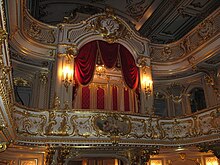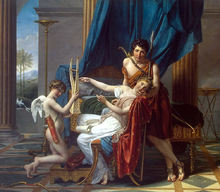
Grigori Yefimovich Rasputin was a Russian mystic and faith healer. He is best known for having befriended the imperial family of Nicholas II, the last Emperor of Russia, through whom he gained considerable influence in the final years of the Russian Empire.

Knyaz Felix Felixovich Yusupov, Count Sumarokov-Elston was a Russian aristocrat from the House of Yusupov who is best known for participating in the assassination of Grigori Rasputin and for marrying Princess Irina Alexandrovna, a niece of Emperor Nicholas II.

Grand Duke Dmitri Pavlovich of Russia was a son of Grand Duke Paul Alexandrovich of Russia, a grandson of Tsar Alexander II of Russia and a first cousin of Tsar Nicholas II, Marie of Edinburgh, King George II of Greece, King Alexander of Greece, Helen of Greece and Denmark,, King Paul of Greece, and Prince Philip, Duke of Edinburgh.

Anna Alexandrovna Vyrubova was a lady-in-waiting in the late Russian Empire, the best friend and confidante of Empress Alexandra Fyodorovna.
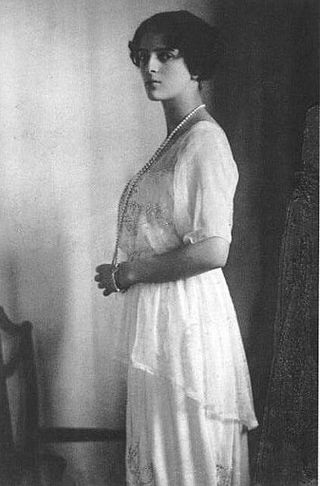
Princess Irina Alexandrovna of Russia was the only daughter and eldest child of Grand Duke Alexander Mikhailovich and Grand Duchess Xenia Alexandrovna of Russia. She was the first grandchild of Tsar Alexander III and the only biological niece of Tsar Nicholas II. Irina was married to the wealthiest man in Imperial Russia, Prince Felix Felixovich Yusupov. Her husband was one of the men who in 1916 murdered Grigori Rasputin, "holy healer" to Irina's hemophiliac cousin, Tsarevich Alexei Nikolaevich.

Vladimir Mitrofanovich Purishkevich was a Russian politician and right-wing extremist known for his monarchist, ultra-nationalist, antisemitic and anticommunist views. He helped lead the paramilitary Black Hundreds during the Russian Revolution of 1905. He later served in the State Duma, where he gained a reputation for courting of public controversy. Together with Felix Yusupov and Dmitri Pavlovich he took part in the assassination of Grigori Rasputin in late 1916.

The House of Yusupov was a Russian princely family descended from the monarchs of the Nogai Horde, renowned for their immense wealth, philanthropy and art collections in the 18th and 19th centuries. Most notably, Prince Felix Yusupov was famous for his involvement in the murder of Grigori Rasputin.
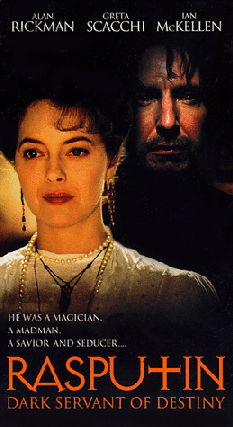
Rasputin: Dark Servant of Destiny is a 1996 biographical historical drama television film which chronicles the last four years (1912–16) of Grigori Rasputin's stint as a healer to Alexei Nikolaevich, Tsarevich of Russia; the heir apparent to the Russian throne as well as the only son of Tsar Nicholas II of Russia and Empress Alexandra Feodorovna; who suffered from hemophilia. The film is narrated in the first person by Alexei.

Maria Rasputin was the daughter of Grigori Rasputin and his wife Praskovya Fyodorovna Dubrovina. She wrote three memoirs about her father, dealing with Tsar Nicholas II and Tsaritsa Alexandra Feodorovna, the attack by Khionia Guseva, and his 1916 murder. The third one, The Man Behind the Myth, was published in 1977 in association with Patte Barham. In her three memoirs, the veracity of which have been questioned, she painted an almost saintly picture of her father, insisting that most of the negative stories were based on slander and the misinterpretation of facts by his enemies.
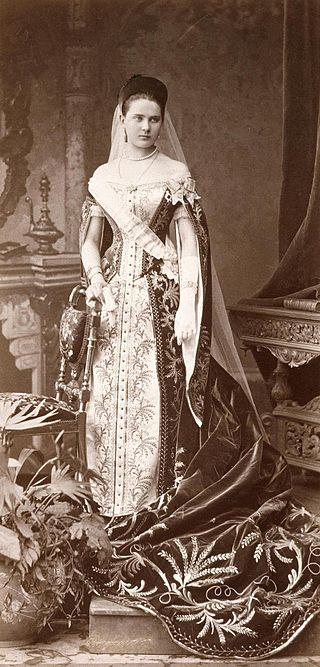
Princess Zinaida Nikolayevna Yusupova was an Imperial Russian noblewoman, the only heiress of Russia's largest private fortune of her time. Famed for her beauty and the lavishness of her hospitality, she was a leading figure in pre-Revolutionary Russian society. In 1882, she married Count Felix Felixovich Sumarokov-Elston, who served briefly as General Governor of Moscow Military District (1914–1915). Zinaida is best known as the mother of Prince Felix Yusupov, the murderer of Rasputin. She escaped revolutionary Russia and spent her remaining years living in exile.

Saint Petersburg has always been known for its high-quality cultural life, and its best known museum is the Hermitage.

The Winter Palace is a palace in Saint Petersburg that served as the official residence of the House of Romanov, previous emperors, from 1732 to 1917. The palace and its precincts now house the Hermitage Museum. The floor area is 233,345 square metres. The total area of the Winter Palace is 14.2 hectares. Situated between Palace Embankment and Palace Square, adjacent to the site of Peter the Great's original Winter Palace, the present and fourth Winter Palace was built and altered almost continuously between the late 1730s and 1837, when it was severely damaged by fire and immediately rebuilt. The storming of the palace in 1917, as depicted in Soviet art and in Sergei Eisenstein's 1928 film October, became a symbol of the October Revolution.
Jean-Baptiste Michel Vallin de la Mothe was a French architect whose major career was spent in St. Petersburg, where he became court architect to Catherine II. His students were Ivan Starov and Vasily Bazhenov.
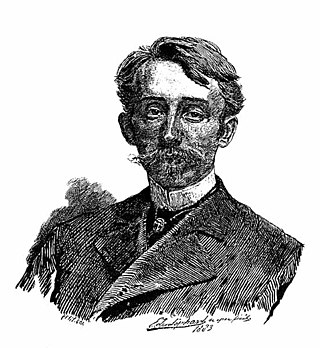
Baron Ernst Friedrich von Liphart (1847–1932), russified as Ernst Karlovich Lipgart and also referred to in English as Earnest Lipgart, was a painter, a noted art expert and art collector from what is now Tartu in Estonia. After living for a time in Florence, he moved to France and then to Russia, where he was a curator at the Hermitage Museum.

Albert Henry Stopford, known as Bertie Stopford, was a British antiques and art dealer specialising in Fabergé and Cartier and diplomatic courier; he was an intimate of the Romanovs. He rescued the jewels of Grand Duchess Vladimir the Elder during the Russian Revolution.

Raspoutine is a 2011 Franco-Russian historical drama television film directed by Josée Dayan and starring Gérard Depardieu, Fanny Ardant, Vladimir Mashkov and Anna Mikhalkova. It centers on the last year in the life of the Russian historical figure Grigori Rasputin.

Rasputin is a 2003 Finnish-language opera in three acts by Einojuhani Rautavaara.
Grigory R. is a Russian television eight-episode historical drama short series focusing on Grigory Rasputin, created by Ilya Tilkin and Eduard Volodarsky, directed by Andrei Malyukov.

Prince Nicholas Felixovich Yusupov, Count Sumarokov-Elston was a Russian aristocrat from the House of Yusupov. He was the elder brother of Felix Yusupov, who was later known as the murderer of Grigori Rasputin.


